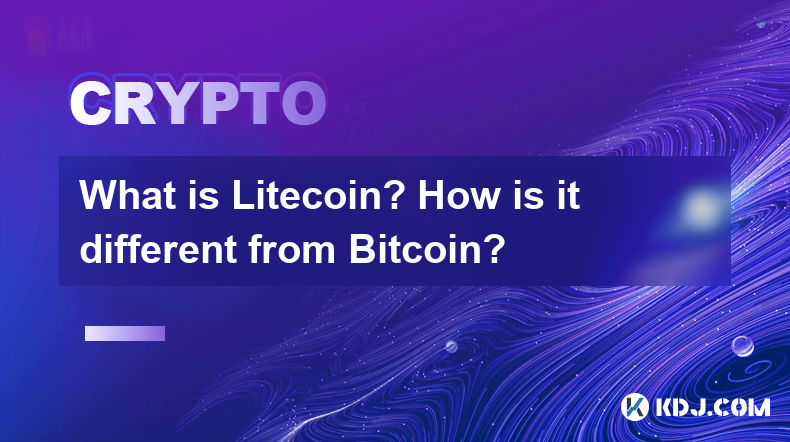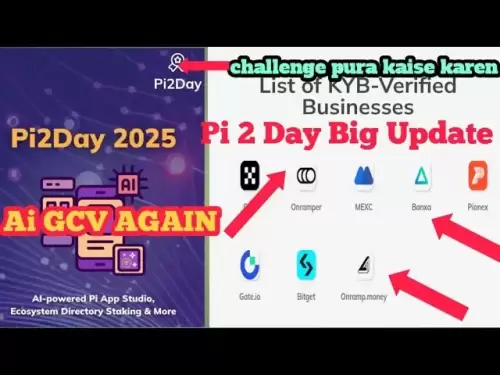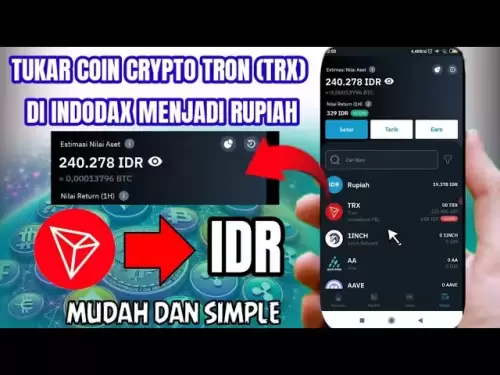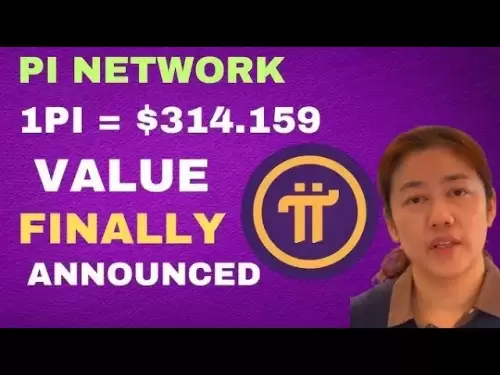-
 Bitcoin
Bitcoin $108,489.6704
1.13% -
 Ethereum
Ethereum $2,502.0528
2.92% -
 Tether USDt
Tether USDt $1.0002
0.00% -
 XRP
XRP $2.1941
0.51% -
 BNB
BNB $655.3375
1.00% -
 Solana
Solana $151.5977
1.27% -
 USDC
USDC $0.9999
0.00% -
 TRON
TRON $0.2768
0.32% -
 Dogecoin
Dogecoin $0.1676
2.86% -
 Cardano
Cardano $0.5675
0.98% -
 Hyperliquid
Hyperliquid $40.6109
7.48% -
 Bitcoin Cash
Bitcoin Cash $500.7746
2.09% -
 Sui
Sui $2.8328
2.03% -
 Chainlink
Chainlink $13.4452
1.26% -
 UNUS SED LEO
UNUS SED LEO $9.1623
0.39% -
 Avalanche
Avalanche $18.2267
2.24% -
 Stellar
Stellar $0.2382
0.00% -
 Toncoin
Toncoin $2.8885
1.68% -
 Shiba Inu
Shiba Inu $0.0...01159
0.91% -
 Litecoin
Litecoin $87.1827
0.88% -
 Hedera
Hedera $0.1511
2.90% -
 Monero
Monero $315.4992
-0.59% -
 Polkadot
Polkadot $3.4663
2.34% -
 Bitget Token
Bitget Token $4.6118
-0.65% -
 Dai
Dai $1.0000
-0.01% -
 Ethena USDe
Ethena USDe $1.0003
0.02% -
 Uniswap
Uniswap $7.2989
4.69% -
 Pepe
Pepe $0.0...01003
5.73% -
 Aave
Aave $275.5616
7.15% -
 Pi
Pi $0.5181
-2.49%
What is Litecoin? How is it different from Bitcoin?
Litecoin (LTC), a peer-to-peer cryptocurrency, offers faster transaction speeds than Bitcoin due to its Scrypt algorithm and shorter block generation time, resulting in lower fees and potentially less price volatility.
Mar 13, 2025 at 02:40 pm

Key Points:
- Litecoin (LTC) is a peer-to-peer cryptocurrency, similar to Bitcoin (BTC), but with key differences in transaction speed and mining algorithm.
- Litecoin boasts faster transaction confirmation times compared to Bitcoin.
- The core difference lies in their underlying cryptographic hashing algorithms: Litecoin uses Scrypt, while Bitcoin uses SHA-256.
- Litecoin's larger total coin supply also contributes to its distinct characteristics.
- Both cryptocurrencies share a similar decentralized structure and utilize blockchain technology.
What is Litecoin?
Litecoin, often referred to as the "silver" to Bitcoin's "gold," is a cryptocurrency launched in 2011. It's an open-source, peer-to-peer digital currency that allows for instant, near-zero cost payments to anyone in the world. Like Bitcoin, Litecoin transactions are recorded on a public, decentralized blockchain, making them transparent and secure. Its primary goal is to provide a faster and more efficient alternative to Bitcoin.
How is Litecoin Different from Bitcoin?
The key differences between Litecoin and Bitcoin lie in several aspects:
- Transaction Speed: Litecoin's block generation time is significantly shorter than Bitcoin's, resulting in faster transaction confirmation times. This makes Litecoin more suitable for everyday transactions where speed is crucial.
- Mining Algorithm: Litecoin utilizes the Scrypt algorithm for mining, while Bitcoin uses SHA-256. Scrypt is designed to be more resistant to specialized hardware (ASICs) than SHA-256, although ASICs are now prevalent in both. This difference initially made Litecoin more accessible to individual miners using standard computer hardware.
- Total Supply: Litecoin has a maximum total supply of 84 million coins, four times that of Bitcoin's 21 million. This larger supply potentially makes Litecoin more accessible and less prone to drastic price fluctuations due to scarcity.
- Transaction Fees: While both networks charge transaction fees, Litecoin's fees tend to be lower than Bitcoin's, especially during periods of high network congestion on the Bitcoin network. This difference can be crucial for users conducting frequent small transactions.
Diving Deeper into the Differences:
Let's examine the key differences in more detail:
- Block Generation Time: Litecoin generates a new block approximately every 2.5 minutes, compared to Bitcoin's 10 minutes. This faster block generation significantly speeds up transaction processing.
- Scrypt vs. SHA-256: The difference in hashing algorithms impacts the type of hardware suitable for mining. While both are now dominated by ASICs, the initial design of Scrypt intended to make it more accessible to individual miners with standard computer hardware.
- Coin Supply Impact: The higher total supply of Litecoin potentially leads to lower price volatility compared to Bitcoin, although market forces always play a significant role in price determination.
- Network Effects: Bitcoin benefits from a larger network effect due to its longer history and greater adoption. This network effect can lead to greater liquidity and more readily available exchanges.
Litecoin's Features and Advantages:
- Faster Transactions: As previously mentioned, the quicker block generation time contributes to faster transaction confirmations, which is advantageous for everyday use cases.
- Lower Transaction Fees: Compared to Bitcoin, Litecoin generally boasts lower transaction fees, making it more cost-effective for smaller transactions.
- Increased Accessibility: While ASICs now dominate both networks, the initial design of Scrypt aimed to provide better accessibility for individual miners.
- Established Ecosystem: Litecoin has a well-established ecosystem with various wallets, exchanges, and merchant integrations.
How Litecoin Works:
Litecoin's functionality mirrors Bitcoin's in many ways. Transactions are verified and added to the blockchain by miners who solve complex cryptographic puzzles. The first miner to solve the puzzle adds the block of transactions to the blockchain and receives a reward in LTC. This process secures the network and ensures the integrity of the transactions.
- Mining: Miners compete to solve cryptographic puzzles using the Scrypt algorithm.
- Transaction Verification: The network verifies each transaction before adding it to the blockchain.
- Blockchain Technology: Litecoin uses blockchain technology to record and secure all transactions.
- Decentralization: The Litecoin network is decentralized, meaning no single entity controls it.
Frequently Asked Questions:
Q: Is Litecoin a good investment?
A: Like any cryptocurrency, Litecoin's investment value is highly speculative and depends on various market factors. Conduct thorough research and assess your risk tolerance before investing.
Q: Can I use Litecoin to buy goods and services?
A: While Bitcoin has broader merchant acceptance, Litecoin is also accepted by some businesses. The number of merchants accepting Litecoin is growing, but it's still less widespread than Bitcoin.
Q: How secure is Litecoin?
A: Litecoin, like Bitcoin, utilizes a robust cryptographic system and a decentralized network, making it highly secure. However, no system is entirely impervious to attacks, and users should always practice good security habits.
Q: How can I acquire Litecoin?
A: You can acquire Litecoin by purchasing it on cryptocurrency exchanges, mining it (although this is increasingly difficult and expensive), or receiving it as payment.
Q: What are the future prospects of Litecoin?
A: The future prospects of Litecoin are uncertain, subject to market forces, technological advancements, and regulatory changes within the cryptocurrency industry. Its potential hinges on its adoption rate and its ability to adapt to evolving market demands.
Disclaimer:info@kdj.com
The information provided is not trading advice. kdj.com does not assume any responsibility for any investments made based on the information provided in this article. Cryptocurrencies are highly volatile and it is highly recommended that you invest with caution after thorough research!
If you believe that the content used on this website infringes your copyright, please contact us immediately (info@kdj.com) and we will delete it promptly.
- Ripple XRP, Bitcoin, and Solaris Presale: What's the Buzz?
- 2025-06-30 18:50:11
- SpaceX, Mirror Tokens, and Investors: A Wild Ride to the Future?
- 2025-06-30 19:10:22
- Arbitrum (ARB) and Robinhood: Partnership Rumors Fuel Price Surge to $0.4289?
- 2025-06-30 19:10:22
- Jasmy Coin, Bitcoin, and the Rise of Solaris Presale: What's the Buzz?
- 2025-06-30 18:30:12
- XRP, SEC, and Ripple: A New Chapter?
- 2025-06-30 19:15:13
- Arbitrum's ARB Price Surges Amid Robinhood Partnership Buzz: A New York Minute on Crypto
- 2025-06-30 19:30:12
Related knowledge

How to customize USDT TRC20 mining fees? Flexible adjustment tutorial
Jun 13,2025 at 01:42am
Understanding USDT TRC20 Mining FeesMining fees on the TRON (TRC20) network are essential for processing transactions. Unlike Bitcoin or Ethereum, where miners directly validate transactions, TRON uses a delegated proof-of-stake (DPoS) mechanism. However, users still need to pay bandwidth and energy fees, which are collectively referred to as 'mining fe...

USDT TRC20 transaction is stuck? Solution summary
Jun 14,2025 at 11:15pm
Understanding USDT TRC20 TransactionsWhen users mention that a USDT TRC20 transaction is stuck, they typically refer to a situation where the transfer of Tether (USDT) on the TRON blockchain has not been confirmed for an extended period. This issue may arise due to various reasons such as network congestion, insufficient transaction fees, or wallet-rela...

How to cancel USDT TRC20 unconfirmed transactions? Operation guide
Jun 13,2025 at 11:01pm
Understanding USDT TRC20 Unconfirmed TransactionsWhen dealing with USDT TRC20 transactions, it’s crucial to understand what an unconfirmed transaction means. An unconfirmed transaction is one that has been broadcasted to the blockchain network but hasn’t yet been included in a block. This typically occurs due to low transaction fees or network congestio...

How to check USDT TRC20 balance? Introduction to multiple query methods
Jun 21,2025 at 02:42am
Understanding USDT TRC20 and Its ImportanceUSDT (Tether) is one of the most widely used stablecoins in the cryptocurrency market. It exists on multiple blockchain networks, including TRC20, which operates on the Tron (TRX) network. Checking your USDT TRC20 balance accurately is crucial for users who hold or transact with this asset. Whether you're sendi...

What to do if USDT TRC20 transfers are congested? Speed up trading skills
Jun 13,2025 at 09:56am
Understanding USDT TRC20 Transfer CongestionWhen transferring USDT TRC20, users may occasionally experience delays or congestion. This typically occurs due to network overload on the TRON blockchain, which hosts the TRC20 version of Tether. Unlike the ERC20 variant (which runs on Ethereum), TRC20 transactions are generally faster and cheaper, but during...

The relationship between USDT TRC20 and TRON chain: technical background analysis
Jun 12,2025 at 01:28pm
What is USDT TRC20?USDT TRC20 refers to the Tether (USDT) token issued on the TRON blockchain using the TRC-20 standard. Unlike the more commonly known ERC-20 version of USDT (which runs on Ethereum), the TRC-20 variant leverages the TRON network's infrastructure for faster and cheaper transactions. The emergence of this version came as part of Tether’s...

How to customize USDT TRC20 mining fees? Flexible adjustment tutorial
Jun 13,2025 at 01:42am
Understanding USDT TRC20 Mining FeesMining fees on the TRON (TRC20) network are essential for processing transactions. Unlike Bitcoin or Ethereum, where miners directly validate transactions, TRON uses a delegated proof-of-stake (DPoS) mechanism. However, users still need to pay bandwidth and energy fees, which are collectively referred to as 'mining fe...

USDT TRC20 transaction is stuck? Solution summary
Jun 14,2025 at 11:15pm
Understanding USDT TRC20 TransactionsWhen users mention that a USDT TRC20 transaction is stuck, they typically refer to a situation where the transfer of Tether (USDT) on the TRON blockchain has not been confirmed for an extended period. This issue may arise due to various reasons such as network congestion, insufficient transaction fees, or wallet-rela...

How to cancel USDT TRC20 unconfirmed transactions? Operation guide
Jun 13,2025 at 11:01pm
Understanding USDT TRC20 Unconfirmed TransactionsWhen dealing with USDT TRC20 transactions, it’s crucial to understand what an unconfirmed transaction means. An unconfirmed transaction is one that has been broadcasted to the blockchain network but hasn’t yet been included in a block. This typically occurs due to low transaction fees or network congestio...

How to check USDT TRC20 balance? Introduction to multiple query methods
Jun 21,2025 at 02:42am
Understanding USDT TRC20 and Its ImportanceUSDT (Tether) is one of the most widely used stablecoins in the cryptocurrency market. It exists on multiple blockchain networks, including TRC20, which operates on the Tron (TRX) network. Checking your USDT TRC20 balance accurately is crucial for users who hold or transact with this asset. Whether you're sendi...

What to do if USDT TRC20 transfers are congested? Speed up trading skills
Jun 13,2025 at 09:56am
Understanding USDT TRC20 Transfer CongestionWhen transferring USDT TRC20, users may occasionally experience delays or congestion. This typically occurs due to network overload on the TRON blockchain, which hosts the TRC20 version of Tether. Unlike the ERC20 variant (which runs on Ethereum), TRC20 transactions are generally faster and cheaper, but during...

The relationship between USDT TRC20 and TRON chain: technical background analysis
Jun 12,2025 at 01:28pm
What is USDT TRC20?USDT TRC20 refers to the Tether (USDT) token issued on the TRON blockchain using the TRC-20 standard. Unlike the more commonly known ERC-20 version of USDT (which runs on Ethereum), the TRC-20 variant leverages the TRON network's infrastructure for faster and cheaper transactions. The emergence of this version came as part of Tether’s...
See all articles

























































































